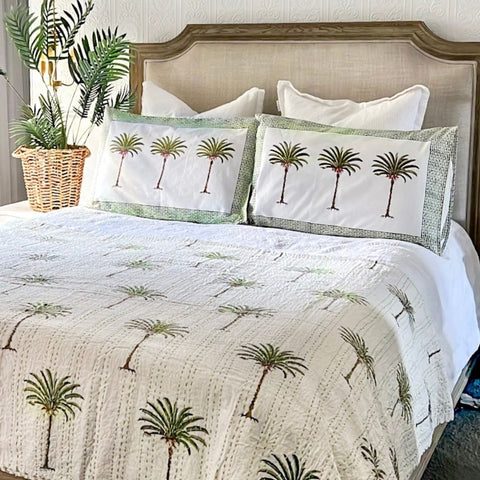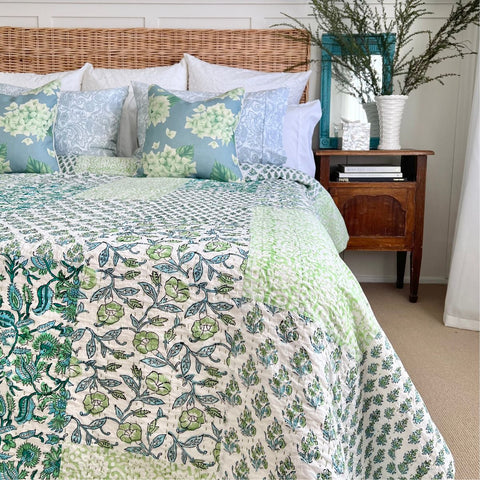Free standard domestic shipping from Queensland across Australia. 30-day returns.
For delivery to the USA and Canada, click here
Free standard domestic shipping from Queensland across Australia. 30-day returns.
For delivery to the USA and Canada, click here
TEN REASONS WHY WE LOVE THE KANTHA QUILT
July 19, 2023 6 min read
A vintage kantha quilt (also known as an Indian bedspread) was originally designed for nothing more than practicality, to keep warm!
To appreciate this classical embroidery, native to eastern South Asia, Bangladesh and Indian states of West Bengal and Odisha, you need to understand the craft and background to it.
"Kantha" refers to both the style of running stitch, as well as the finished cloth. (old cloth, saris or rags that are reused to make a recycled quilted blanket to provide warmth and protection to loved ones).
The kantha story, however, goes back a long time, produced for centuries by impoverished Bengali women. Kantha involves thousands of small, running, intricate stitches done by hand on soft cotton fabrics. The tradition behind this intricate, unique, and well stitched generational artistry is so special, and often made for wedding gifts by the women from the Bengal region, taking the cloth from scraps and sewing them together to make repurposed quilts.
It is a known fact that a generation of women would work on the same quilt, turning it into an heirloom passed down for centuries.
On our recent visit to a small cluster in India, we were fortunate to witness the art being practised by the local, rural women. For these women, Kantha quilting is a way of life. On any given day, you'll find groups of women, young and old, chatting and quilting away to glory, creating one masterpiece after another..
For them, Kantha quilting is just a means of livelihood, but a craft that remind them of their ancestors, mostly mothers and grandmothers, and many years of traditions that they are trying to keep alive.
So you see, there are many reasons why we love Kantha quilts, but here are just ten and why your Kantha can take centre-stage in your home.
1. A Collective Craft
Kantha was a domesticated craft that women practised whilst running a house and looking after children, hence why it was often passed down from mother to daughter and it could take some time to finish a piece. For this reason, a kantha would hold memories and life stories, all within a family’s history.
2. Layers of Skill
One of the many reasons why kantha quilts are a popular item is the lightweight cotton layers which make up this Indian bedspread. Often compared to a soft baby muslin blanket, the standard kantha quilt will most likely consist of three layers of old cloth, often already worn away, adding to its soft nature. A heavier thickness (in native regions where it is quite cold) would consist of up to six layers to accommodate the more extreme weather conditions.
3. Artform in Stitching

The various stitching, the most common being the straight running stitch over the ‘edge stitching’, which is less expensive and lower in quality. You see, the closer the stitch, the better made the kantha blankets are, making them more durable.

It is all in the stitching and kanthas are making a comeback making them environmentally friendly with their natural cotton makeup. Colour and intricate details are typical of a kantha quilt, hence why it is a popular choice in western society.
4. Authenticity

The Kantha running stitch is the earliest of its form, and often consisting of a geometric design or figures depicting stories within a family’s history, hence why the Kantha coverlet is often referred to as ‘generational artistry’ revealing a story. They are typically handmade and vary in colour, size, and pattern.
5. Elaborate Patterns


In keeping with the kantha traditions, more involved patterns developed, known as ‘nakshi kantha’ deriving from Bengali, meaning ‘artistic patterns’ often influenced by culture and the actual women who stitch them. This fine piece would depict birds, sea life, floral or plant designs. Both sides of a kantha are decorative but not always the same. There can be block or screen printed Kantha throws and quilts, where the fabrics are first hand printed, and then hand stitched.
6. Repurposing for the Future
We all want only good things for our planet and applying the art of ‘repurposing’ should sit well with anyone who is looking to decorate their abode, as it displays awareness and aids in the contribution of a better planet.
Once again, as long as 500 years ago, kantha quilts were made by the poor women of west Bengal in India who sourced saris and old cloths for their children and to this day, kantha quilts can still be found to be made from old saris or unwanted fabrics, but re-stitched together, making it an upcycling process for generations to come.
As a society we need to keep looking at sustainability and repurposing whichever way we can. Essentially, our interiors should define who we are and fit our natural environment, avoiding waste as much as possible.
7. Varying Uses
Kanthas have many uses and were created in varying sizes for floor covers, pillow covers, purses and even as prayer mats.
8. An Empowering Skill that has Evolved
Since the 1980’s kantha has evolved substantially, thanks to people like Shamlu Dudeja founder of an organisation named Self-Help Enterprise (SHE). She had a vision and wanted to empower women into using their skill to craft and make a living, and ‘revive’ kanthas. Dudeja incorporated this into furnishings, home décor and apparel.
She helped the artisans working with SHE, and this spread the craft to a larger group so that more rural women would be able to also earn a living using their skills, whilst still working from home and provide care for their children.
9. Keeping Tradition Alive
Although a century old tradition, Kantha is often featured among international designer brands to this day, in both apparel and furnishings. With its distinguishing art form of a rich culture, it is drawing more and more designers’ attention.
10. How to Style a Kantha Today
With a feeling of warmth and comfort, Kanthas resonate particularly well with Australian interiors, offering a relaxed and liveable feel to a space. Australian winters can be classified as ‘mild’ in comparison to other parts of the globe, and traditionally a kantha design favours as a ‘light covering’ which is used during the mild Bengali winters.
Including a kantha in your home somewhere, anywhere, whether as a throw, coverlet, or blanket, it will effortlessly morph into even the most undemanding interior, at any time of the year!
Apart from vintage kantha quilts, there are also hand block and hand screen printed kanthas where the fabrics are first printed and then hand stitched.
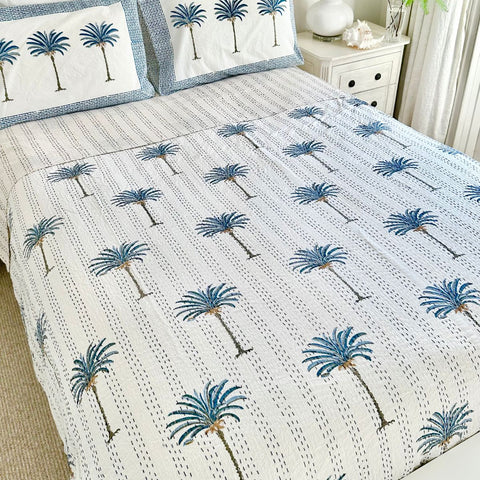
Hamptons Blue palm Kantha quilt
A kantha can be that extra layer over a quilt or folded back down the end of your bed during the warmer months.
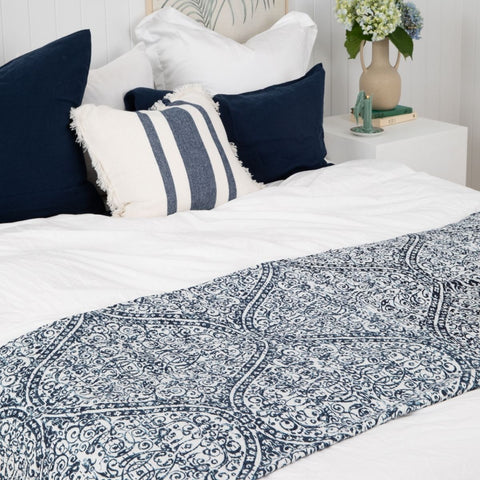
Navy blue and white kantha throw
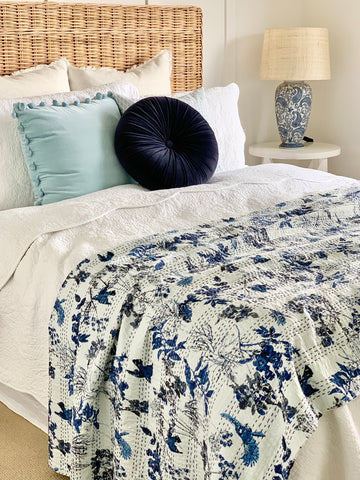
Owning a Kantha creates an eclectic feel in the home and can be styled in many ways.
Consider changing things up and decorate a kantha as an elaborate throw to shape your sofa or armchair. It can be that special ‘piece’ in the foreground of your living room or bedroom, adding a sense of playful colour and style.
You may think mixing colours and patterns demands some expertise, but at the end of the day it is all about seeking a connection to nature and your own surroundings
A patchwork kantha quilt is a truly one-of-a-kind product. Each piece is unique and is made from a mix of timeless block prints on 100% cotton. Using all the small leftover pieces of fabric is what makes this product sustainable in the truest sense.
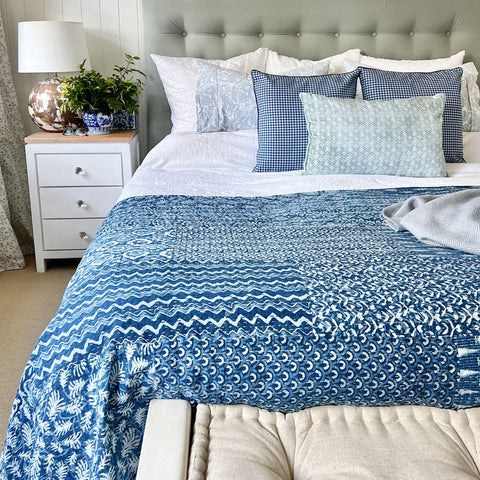
Most kantha quilts/coverlets are typically colourful and if teamed up correctly with complementing cushions and accessories, they can breathe life into your 21st-century space.
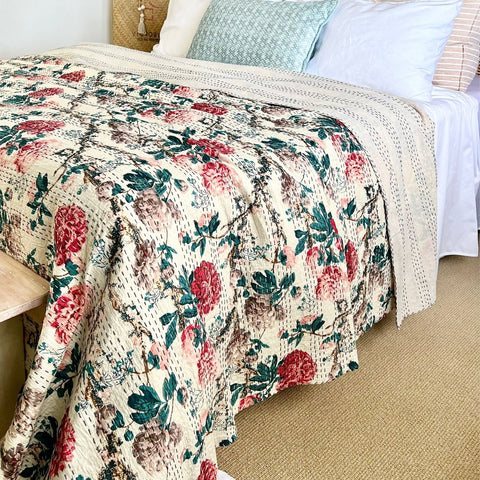
Conclusion
To own a kantha blanket is to experience a unique and versatile hand-stitched piece that will last you a lifetime.
Take a look at our eclectic collection of Kantha quilts / Indian bedspreads here
Leave a comment
Comments will be approved before showing up.


